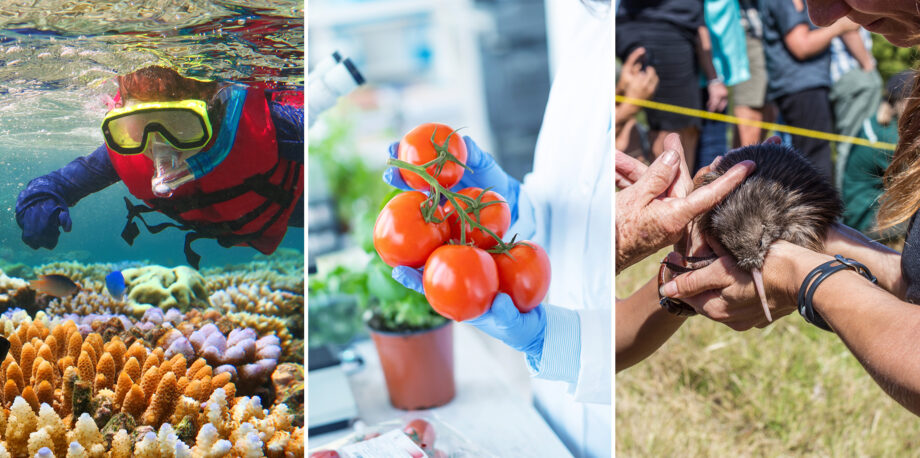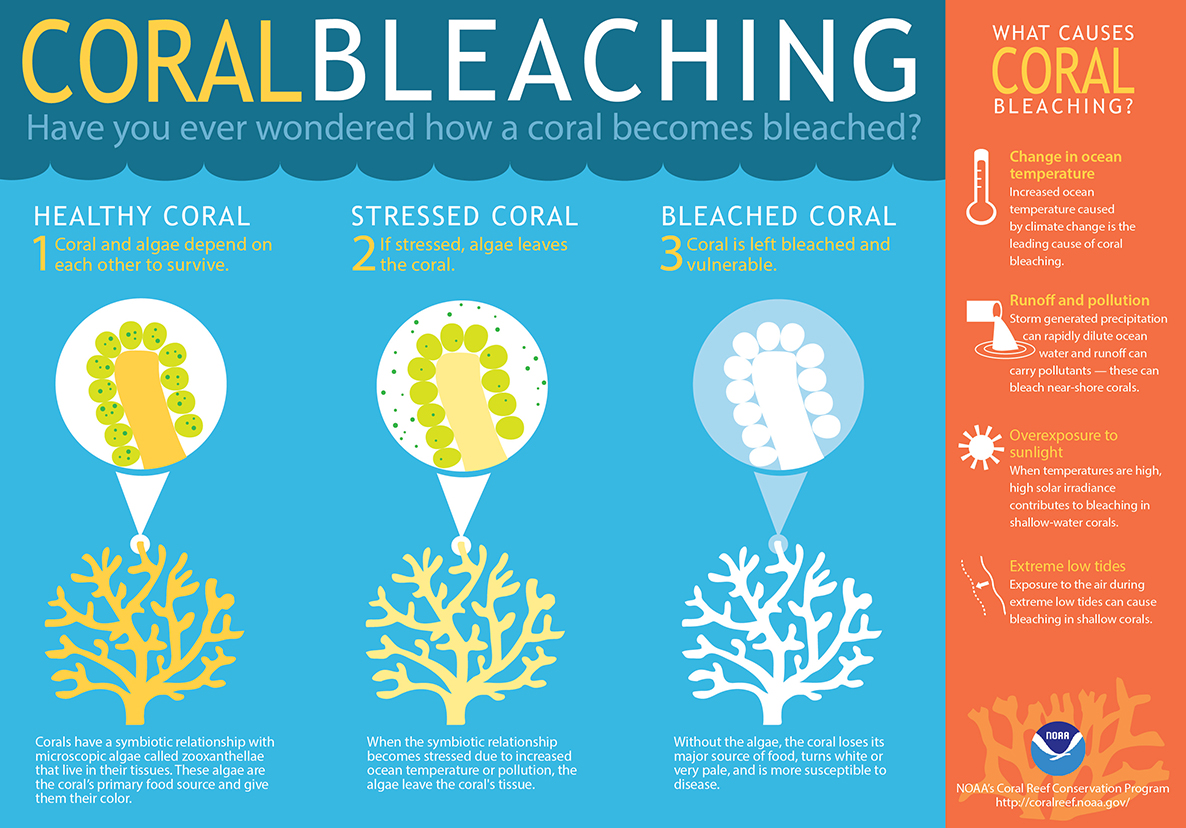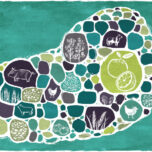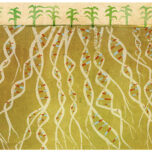September 13, 2019 — It’s been an alarming year for the world’s outlook on biodiversity. The Intergovernmental Science-Policy Platform on Biodiversity and Ecosystem Services (IPBES) put the world on notice that around 1 million species are facing extinction. A study published in August concluded that it would take New Zealand 50 million years to recover the diversity of bird species it has lost since human colonization. And, while headlines about an insect apocalypse may have been hyperbolic, insect biodiversity is decreasing, and it’s a problem.
As evidenced in the IPBES report, current conservation efforts have not been sufficient to stem biodiversity loss, so innovative solutions might be necessary to support the web of life that supports human existence. In 2012, scientists first described the gene editing capabilities of CRISPR, a molecular tool that can be used to make targeted, precise changes to the DNA of plants, animals and microbes. Since then, scientists have proposed myriad ways to use the technology. But could it be a boon to biodiversity? Can it help researchers understand and preserve corals and their ecosystems? What about applications to diversify agriculture to shore up food security? Or to combat invasive species plaguing ecosystems around the world?
While many scientists are eager to discuss the possibilities of using CRISPR to preserve biodiversity, they are also cautious. The effects of human interventions are not always predictable, and once a gene-edited species is released into the wild, controlling any negative effects will be difficult. Toni Piaggio, a research scientist at the U.S. Department of Agriculture (USDA) National Wildlife Research Center, says researchers should “never entirely sip the Kool-Aid” when it comes to CRISPR. Instead, she says, they should “spend a lot of research time and intellectual energy” questioning themselves and their work. Posing the right questions to the right stakeholders — including communities that would be affected by the application of gene editing — might help to avoid the unintended consequences that so often accompany human solutions to ecosystem challenges.
Diversity for Food Security
About 12,000 years ago, ancient people began cultivating the wild ancestors of many of the plants we eat today. Over time, they selected seeds from plants that evolved helpful traits to plant in future years. As a result, a plant called teosinte with 5 to 12 kernels in rock-hard casings gave rise to corn, and the small red berries of wild tomatoes gave rise to tomatoes of today. This process of crop domestication was a turning point for humans. It allowed us to settle into communities and build societies.
But as millennia passed, domestication also decreased the genetic diversity within the plants we grow and eat. To understand why, imagine an ancient human 10,000 years ago, tired of smashing teosinte with rocks to get a few measly kernels out of their hard casings. If that person saw a plant with naked kernels — exposed and available to eat without rock smashing — they might select seeds from that plant to grow the next year. That works out great for the person, but the genetic diversity in the rest of the field is lost to future generations.
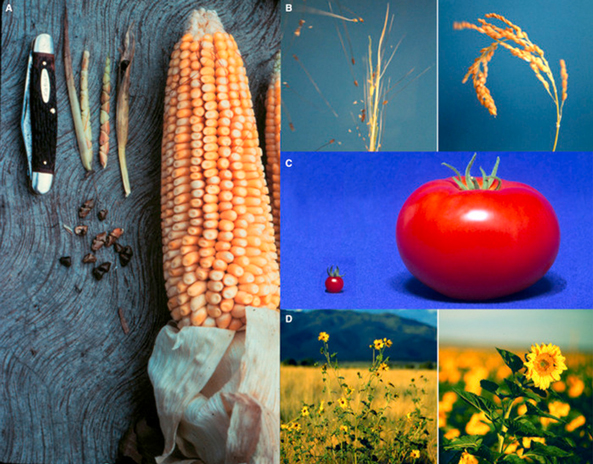
Domestication of plants like tomatoes, rice and corn helped increase crop yields and make farming more predictable. But it also reduced genetic diversity — something that could be a problem with more erratic weather in the future. Image courtesy of Markus G. Stetter, Daniel J. Gates, Wenbin Mei, Jeffrey Ross-Ibarra via Current Biology, Volume 27, Issue 17; “How to make a domesticate”; Pages R896-R900 Licensed under Elsevier user license
The same forces are at play today. When each tomato plant, for example, looks the same, grows at the same rate, and produces pounds upon pounds of tomatoes, farming is easier and the food supply is more predictable — if everything goes as usual.
Problem is, farming doesn’t always follow usual, expected patterns. And climate change is increasing variability and unpredictability in agriculture. Many crops, as a result of their low genetic diversity, are not particularly well suited to cope with emerging climate patterns, leaving them susceptible to challenges like drought, flooding or salty soils. So, says Lázaro Peres, a professor of plant physiology at the University of São Paulo, relying on a limited number of crop species to produce the world’s food is risky.
Peres and other researchers are trying to infuse agriculture with the genetic diversity of wild species. His research team started with a wild tomato and used CRISPR to edit a handful of key genes. Their goal was to make the versions of the genes in wild tomato look like the versions of the genes in domesticated tomato. In doing so, the wild tomato species gained some beneficial characteristics common to domesticated species. Through this process, called “de novo domestication,” Peres and colleagues produced a tomato with more fruit, bigger fruit and more lycopene than wild tomatoes and that are genetically diverse from conventional domesticated tomatoes.
Such diversity, they say, might mean that farmers coping with various climatic stresses will have access to domesticated tomato species suited to the unique challenges they face.
But, looking beyond a single crop into the ecosystem within which it exists is important, says Yolanda Chen, an associate professor in the College of Agriculture and Life Sciences at the University of Vermont. Chen studies the impact plant domestication can have on insect populations. She says that researchers need to consider how genes “operate within a broader community context” and not just in a single plant. Does a change in plant size or color affect which insects are attracted to it? How does that affect the predators of those insects?
Peres is mindful of the potential effects on agricultural ecosystems. Domesticating a wild tomato and growing it at scale could impact nuanced ecological relationships. Still, he says, he “sees mainly positive things” about the potential impacts of his work. “And one of the things is food security, because it is quite dangerous to depend on very few species for our food, feed and fiber.”
Chen says that she thinks gene editing for de novo domestication is “less risky” than other genetic approaches, such as those that introduce entire new genes into a plant species. In de novo domestication, the edited versions of genes already exist in related domesticated tomato plants.
It will likely be a while before a new species of tomato developed to increase the genetic diversity of our food is available at the local grocery store. Peres says the work he and his group have published so far was a proof of concept; in other words, they showed that de novo domestication is feasible, but have no plan to commercialize that tomato. They’ve since turned their attention to a species of wild tomato from the Galápagos Islands that grows especially well in salty soils and is resistant to a white fly that can cause severe crop damage. If they are able to de novo domesticate this tomato, it could be used as an important crop for farmers dealing with salty, coastal soils.
In the end, Chen and Peres are both concerned about climate change, agriculture and biodiversity. They approach solutions to these concerns from different research perspectives, but both see diversity — on the genetic and species levels — in agricultural ecosystems as an important aspect of a food system that can withstand the challenges of climate change. In the future, domesticating new plant species — potentially with gene editing — might give farmers more options for growing diverse crops well-suited to specific climates.
Coral Conservation
In 1770, British explorer Captain James Cook ran his ship, The Endeavor, aground on the “insane labyrinth” that would become known as the Great Barrier Reef off the coast of Queensland, Australia. While Cook was credited with “discovering” the reef, coral reefs had been important to indigenous people for centuries before.
A few hundred years later, pollution and warming water have resulted in huge coral bleaching events around the world. While corals can survive bleaching, the stress does lead to increased mortality. That’s bad news for the marine species that inhabit corals. When corals are lost, reef ecosystems suffer, throwing the relationships between the thousands of species— including fish, invertebrates, plants, turtles and more — that live there out of balance.
Bleaching occurs when the symbiotic relationship between corals and the algae they live with becomes stressed — for example, by warm waters. As a result of the stress, corals expel the algae, resulting in bleached coral. Bleaching events began to increase in frequency and magnitude in the 1980s. Between 2014 and 2017, high ocean temperatures precipitated major global coral bleaching events.
Current conservation efforts for the world’s corals have been insufficient to curb bleaching events and sustain the valuable ecosystems corals support, according to the IPBES report. So there is a certain urgency to finding new approaches to conservation. A 2019 report by biologists laid out different conservation approaches and evaluated their potential risks and benefits. And with the 2018 announcement that scientists have used CRISPR to edit genes in coral, gene editing is seen as a potential strategy. Maybe.
Conservation scientists, Piaggio says, are “just as concerned about the technology as anyone that I’ve ever met or talked to about it.” Scientists using gene editing on corals are no exception. In fact, they are quite clear: They are not using gene editing to make heat-resistant corals to populate the ocean. Their intent is to use CRISPR to understand, in a laboratory setting, which coral genes are important for handling stress in the environment and use that information to help other coral conservation efforts.
Marie Strader, now an assistant research professor at Auburn University, was a lead researcher as a graduate student on the international team of scientists that produced the work. The scientists edited three types of genes in a vibrantly colored coral called Acropora millepora. The goal of the editing was to “break” or mutate the genes, and in some of the larvae, it did.
Since this proof-of-concept study was successful — meaning they were able to edit the coral genes they targeted at least some of the time — other researchers can use their methods as a blueprint for editing other genes in Acropora millepora and editing other coral species. For starters, Strader says, they’ll likely be looking at genes involved in the coral life cycle and temperature sensitivity. Understanding those processes, Strader says, can “translate into conservation efforts down the line.”
For example, researchers can use CRISPR in the lab to help them understand which genes are important for tolerance to warm waters. If they edit a gene in the lab and the resulting coral can better tolerate warm waters, then, according to Strader, the scientists could look at natural coral populations for those that naturally have that genetic mutation. Armed with that understanding, researchers might be more successful at conservation efforts such as breeding corals to help them keep their cool as the heat turns up.
So why don’t scientists want to populate the ocean with heat-tolerant, CRISPRed corals?
For one thing, there are still plenty of technical obstacles. In Strader’s work, individual edited corals ended up with a mix of edited and unedited copies of the genes. To realize the full effect of a gene edit and to pass it down to future generations, each cell of the coral should ideally have the same edit. And other details, such as making sure CRISPR edits only the targeted gene or genes, “need to be worked out before it would be a viable option for conservation purposes,” Strader says.
Furthermore, says John Bruno, a marine ecologist at the University of North Carolina at Chapel Hill, conservation efforts need to protect not just corals but also the thousands of other species that rely on them. According to Bruno, gene editing 10 or 20 species of corals to tolerate warm water just isn’t enough. Since “nobody’s going to CRISPR all billion species that are in the ocean,” he says, conservation needs to focus on the whole ecosystem and not just a few species. “The solution is rather obvious, just radically mitigate greenhouse gas emissions,” he says — acknowledging that’s no easy feat.
Running Interference
The situation with corals is “dire,” according to Bruno. But even in coral species that have seen precipitous declines, there are often still many — potentially on the order of millions — of individuals left, he says.
Back on shore, some animal populations are much smaller and could easily slip out of existence under the thumb of invasive species. In New Zealand, native birds evolved without mammalian predators. Many are large and flightless, so when mammals like rats, possums and stoats arrived with humans, the birds were easy targets. According to one study, these invasive animals are responsible for the loss of an estimated 26.6 million chicks and eggs of native bird species each year.
Despite serious conservation efforts, many New Zealand bird species are extinct or endangered. To save those left, the New Zealand government has set an ambitious goal to rid the country of its mammalian pests by 2050. As it stands now, invasive species are often managed with traps and toxicants, which aren’t pleasant ways to die, Piaggio notes.
Gene drives, which have become more plausible with the advent of gene editing, could offer a more humane way of managing invasive populations and protecting the species they endanger.
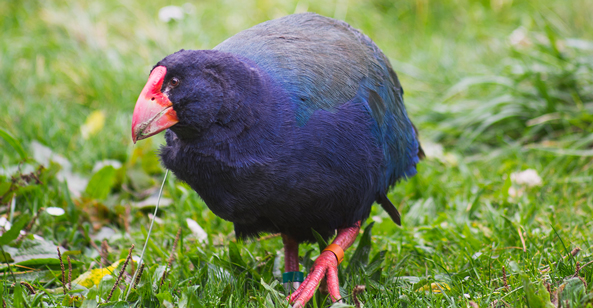
In New Zealand, native birds evolved without mammalian predators. Many are large and flightless, so when mammals like rats, possums and stoats arrived with humans, the birds were easy targets. The takahe, pictured here, is one such bird — thought to be extinct until it was rediscovered in 1948. Photo © iStockphoto.com/Tommy Farling
Put simply, a gene drive changes the odds of inheriting a trait, such as sex. If one out of every 10 possum births is male instead of the normal five out of 10, reproductive opportunities for the females will decrease.
If rats, possums or stoats were gene edited in this way, it could release some of the pressure on threatened and endangered New Zealand birds.
Unfortunately, as evidenced by mongooses in Hawaii and cane toads (or Bart Simpson’s bullfrog) in Australia, humans have a less-than-perfect track record when it comes to intervening in ecosystems.
“So many things have been done with the best possible intention, and we find that there’s just been unforeseen consequences,” says Helen Taylor, a conservation geneticist and honorary research fellow at the University of Otago. She points out that while possums are pests in New Zealand, they are an important species in Australia. If a possum with the New Zealand gene drive were somehow released in Australia, the effects could be devastating.
Maud Quinzin, a conservation geneticist and senior postdoctoral associate, recently began working in MIT’s Sculpting Evolution Lab with Kevin Esvelt, the scientist who first proposed CRISPR as a tool to create gene drives. Quinzin is using her understanding of ecosystem dynamics to help the Sculpting Evolution Lab think about the complex rippling effects of human interference in ecosystems.
It’s important to look at the science from all angles, she says. “Developing gene-editing tools requires scientists with very different expertise sharing ideas and progress from early on in the process.” For example, if an invasive rat species is eradicated from an island, will other species — even other invasive species — become more populous? “You have to think about … the dynamic in that ecosystem,” she says. Since suggesting that CRISPR could be used for gene drives, Esvelt himself has been vocal about his concerns.
Still, Quinzin has been on the front lines of conservation biology, watching populations of valued species go extinct, and she wants communities to be presented with all options for conservation. For scientists to present those options, though, they really need to understand the places where they might work, Quinzin says. That understanding comes not just from researchers, but also from the people who live in those places. “It is really important that you respect the values and the knowledge in a place,” Quinzin says, including “not only the scientific information but also the indigenous or local knowledge.” By engaging with local communities as technology develops, Quinzin says, researchers can focus on developing technology in ways that align with a community’s cultural, social, political and environmental values.
Moving Forward
In the short term, agriculture might be the most likely use of CRISPR to protect biodiversity. In fact, the first gene-edited crop hit the market in the United States in early 2019. Individual countries are still figuring out how to regulate edited plants, with a big distinction being made between plants that could have emerged through natural mutations and plants containing larger edits, like those containing new DNA.
At the very least, the work of scientists like Peres could expand the genetic diversity of our crop plants, adding more options to the table as farmers, scientists and other stakeholders work toward a food-secure world. And having options is important. No single solution can save biodiversity everywhere. And carelessly applied solutions can cause more problems.
Scientists do seem to be proceeding with caution. At least some coral researchers decline to consider using CRISPR in the wild. Scientists studying gene drives are vocally pointing out the limitations of the technology and extolling the role nonscientists must play in the decisions to use or not use CRISPR for conservation purposes.
“I think we have a really big — not just opportunity, but an obligation to get it out there in the public eye as much as possible,” Piaggio says. And if scientists don’t get public buy-in, they shouldn’t use the technology, she says. “I think we have to be okay with that.”
Quinzin says that she and other scientists in her group want guidance from the public. At the same time, she notes that CRISPR “could be such an amazing tool if we are respectful [and] responsible and use it properly.”
There are no perfect or universal solutions to the biodiversity crisis the world is facing. And the causes cannot be forgotten in pursuit of an antidote. That’s why it will take scientists and conservationists with diverse approaches working in different areas to make a difference.
Related Posts
Ensia shares solutions-focused stories free of charge through our online magazine and partner media. That means audiences around the world have ready access to stories that can — and do — help them shape a better future. If you value our work, please show your support today.
Yes, I'll support Ensia!